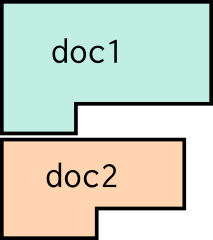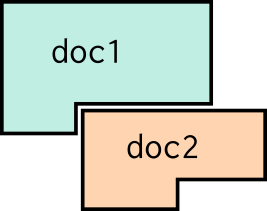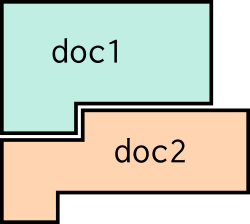pretty-fast-pretty-printer
v0.10.0
Published
A linear time pretty printing library
Downloads
29
Readme
Pretty Fast Pretty Printer
For an introduction to the Pretty Fast Pretty Printer and how to use it, please see the guide.
This readme is the reference manual.
Pretty printing is an approach to printing source code that can adapt how things are printed to fit within a maximum line width.
To use this library:
- Convert the source code you want to print into a document (instance of
Doc), using the constructors below. TheDocwill encode all possible ways that the source can be printed. - Print the
Docusingdoc.display(width), wherewidthis the maximum allowed line width. This will return a list of lines.
There are a variety of pretty-printing algorithms. The pretty-fast-pretty-printer uses a custom algorithm that displays a document in time linear in the number of distinct nodes in the document. (Note that this is better than linear in the size of the document: if a document contains multiple references to a single sub-document, that sub-document is only counted once. This can be an exponential improvement.)
The algorithm takes inspiration from:
- Wadler's Prettier Printer,
- Bernardy's Pretty but not Greedy Printer, and
- Ben Lerner's Pyret pretty printer
This pretty printer was developed as part of Codemirror Blocks. Don't let this stop you from using it for your own project, though: it's a general purpose library!
Kinds of Docs
Documents are constructed out of six basic combinators:
txt: Text
txt(string) simply displays string. The string cannot contain newlines.
txt("") is an empty document.
For example,
txt("Hello, world")
.display(80);produces:
Hello, world
All other combinators will automatically wrap string arguments in txt.
As a result, you can almost always write "a string" instead of txt("a string").
vert: Vertical Concatenation
vert(doc1, doc2, ...) vertically concatenates documents, from top to bottom.
(I.e., it joins them with newlines). The vertical concatenation of two
documents looks like this:

For example,
vert("Hello,", "world!")
.display(80)produces:
Vertical concatenation is associative. Thus:
vert(X, Y, Z)
= vert(X, vert(Y, Z))
= vert(vert(X, Y), Z)horz: Horizontal Concatenation
horz(doc1, doc2, ...) horizontally concatenates documents. The second document
is indented to match the last line of the first document (and so forth for the
third document, etc.). The horizontal concatention of two documents looks like
this:

For example,
horz("BEGIN ", vert("first line", "second line"))
.display(80)produces:
Horizontal concatenation is associative. Thus:
horz(X, Y, Z)
= horz(X, horz(Y, Z))
= horz(horz(X, Y), Z)horzArray(docArray) is a variant of horz that takes a single argument that
is an array of documents. It is equivalent to horz.apply(null, docArray).
concat: Simple Concatenation
concat(doc1, doc2, ...) naively concatenates documents from left to right. It
is similar to horz, except that the indentation level is kept fixed for
all of the documents. The simple concatenation of two documents looks like this:

You should almost always prefer horz over concat.
As an example,
concat("BEGIN ", vert("first line", "second line"))
.display(80))produces:
concatArray(docArray) is a variant of concat that takes a single argument
that is an array of documents. It is equivalent to concat.apply(null, docArray).
ifFlat: Choose between two Layouts
ifFlat(doc1, doc2) chooses between two documents. It will use doc1 if it
fits entirely on the current line, otherwise it will use doc2. More precisely,
doc1 will be used iff:
- It can be rendered flat. A "flat" document has no newlines,
i.e., no
vert. And, - When rendered flat, it fits on the current line without going over
the pretty printing width. NOTE: this counts only the portion of the current line contained in
the
ifFlatand to its left; it does not count anything to its right. Mostly this doesn't matter much, but it can result in a document being printed over multiple lines when one would do. If this ends up being an issue, try moving more of the Doc into theifFlatchoice.
fullLine: Prevent More on the Same Line
Finally, fullLine(doc) ensures that nothing is placed after doc, if at all possible. More
specifically, ifFlat choices will be made such that nothing appears to the right of the
fullLine(doc), if at all possible. However, if something is displayed unconditionally to the
right of the fullLine, this library will have no choice but to put it there.
This is helpful for line comments. For example, fullLine("// comment") will
ensure that (if at all possible) nothing is placed after the comment.
Other Constructors
Besides the combinators, there are some other useful "utility" constructors. These constructors don't provide any extra power, as they are all defined in terms of the combinators described above. But they capture some useful patterns.
String Templates
There is also a
string template
shorthand for building a doc, called pretty. It accepts template strings that
may contain newlines. It combines the lines with vert, and the parts of each
line with horz, returning a Doc. For example, this template:
let c = "a == b";
let t = "a << 2";
let e = "a + b";
pretty`if (${c}) {\n ${t}\n} else {\n ${e}\n}`
.display(80)pretty prints an if statement across multiple lines:
if (a == b) {
a << 2
} else {
a + b
}SepBy
sepBy(items, sep, vertSep="") will display either:
items[0] sep items[1] sep ... items[n]if it fits on one line, or:
items[0] vertSep \n items[1] vertSep \n ... items[n]otherwise. (Without the extra spaces; those are there for readability.)
Neither sep nor vertSep may contain newlines.
Wrap
wrap(words, sep=" ", vertSep="") does word wrapping. It combines the words with
sep when they fit on the same line, or vertSep\n when they don't.
For simple word wrapping, you would use:
wrap(words, " ", "") // or just wrap(words)For word-wrapping a comma-separated list, you would use:
wrap(words, ", ", ",")Neither sep nor vertSep may contain newlines.
S-Expression Constructors
There are also some constructors for common kinds of s-expressions:
Standard
standardSexpr(func, args) is rendered like this:
(func args ... args)or like this:
(func
args
...
args)Lambda-like
lambdaLikeSexpr(keyword, defn, body) is rendered like this:
(keyword defn body)or like this:
(keyword defn
body)Begin-like
beginLikeSexpr(keyword, bodies) is rendered like this:
(keyword
bodies
...
bodies)